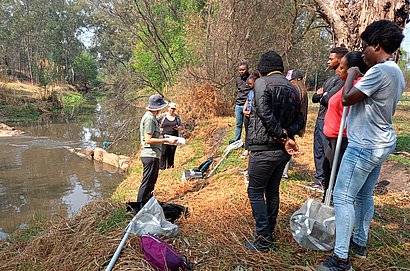During World Water Monitoring Day, the Environmental Science team at IIE MSA invited staff members to join them in citizen science-based water monitoring tests at the Wilgespruit, situated at the lower end of the IIE MSA property. Since 2015, the Environmental Science team, along with postgraduate students, have been monitoring the Wilgespruit to track changes in the river’s ecological condition.
“The advantage of long-term monitoring is that it allows us to observe trends over time and assess the effects of various events—such as sewage spills or rainstorms—on the river system. In contrast, once-off monitoring provides only a snapshot of current conditions, which may not reflect the broader or long-term changes occurring within the river or catchment, such as seasonal variations” says Linda Downsborough, the head of Environmental Science.
Staff from the disciplines of Social Science, Commerce, and Education, along with third-year Geography students, joined the Environmental Science team to perform three citizen science-based water monitoring tests. These tests measure different parameters, offering insight into the current ecological condition and basic water quality of the Wilgespruit.

The first test conducted was a miniSASS stream assessment, which involves collecting and identifying macroinvertebrates from the river ecosystem. Different macroinvertebrates have varying levels of sensitivity to water conditions—some can survive in poor water quality, while others require fair to good water conditions to thrive. Two samples were collected from the Wilgespruit. These samples indicated that the ecological condition was poor to very poor, as evidenced by the presence of tolerant species like worms, leeches, and mayflies. These results were consistent with what the team has observed over the past 2-3 months.

The second test used a Freshwater Watch kit, provided by a UK-based NGO, to measure phosphate and nitrate levels in the water. Elevated phosphate levels often indicate agricultural runoff, while high nitrate levels suggest human-induced effluent. The test showed low phosphate levels, which is typical for a semi-urban area, but the nitrate levels were relatively high.
The final test, provided by WaterCan, focused on basic water parameters such as pH levels, phosphates, nitrates, and minerals/metals, along with specific tests for E. coli and bacterial coliforms. These tests were conducted over a 72-hour period and confirmed the presence of E. coli and coliform bacteria in the water, though they did not indicate the concentration levels.
The data collected from these tests will contribute to ongoing citizen science projects led by the Centre for Water and the Environment, including the National State of Rivers report, facilitated by Ground Truth South Africa. The day was filled with learning, collaboration, and fun, and we look forward to expanding our long-term monitoring efforts across various faculties and student bodies at IIE MSA.

